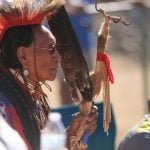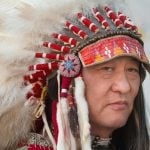The Nez Perce In Canada
On October 5, 1877, following six days of siege by American army troops and artillery known as the Battle of the Bear Paw, Nez Perce Chief Joseph delivered his rifle to Colonel Nelson Miles and officially surrendered. According to the official army accounts a total of 418 Nez Perce surrendered: 87 men, 184 women, and 147 children. Among those who surrendered was Halahtookit (Daytime Smoke), the son of Captain William Clark, and his daughter and granddaughter. For most history books, this marked the end of the Nez Perce War, one of two officially designated Indian wars.
On October 22, 1877, North-West Mounted Police Superintendent James Walsh met in council with the Nez Perce near Wood Mountain, Saskatchewan. Meeting in the center of Sitting Bull’s Sioux camp, the Nez Perce chief White Bird recounted the struggles of his people and how they had come to seek asylum in Canada. Walsh counted 290 Nez Perce refugees living among the Sioux: 90 men and 200 women and children. The story of these refugees-nearly half of the Nez Perce who had survived their long battle from Oregon and Idaho, through Yellowstone National Park, and across Montana-is often omitted from the history books.
The Battle of the Bear Paw:
A few miles from Canada, in Montana’s Bear Paw Mountains, the Nez Perce bands stopped to rest. This was an area well known to them from their buffalo-hunting and trading expeditions onto the Plains. They called the area Tsanim Alikos Pah (Place of the Manure Fires), and they knew that Canada lay but forty miles away.
In the morning, Wotolen told the people that he had had a dream about this place and that in the dream the sky had been dark with the smoke of battle and that the waters of the creek were running red with blood. When the scouts reported that they had seen American troops coming, many of the Nez Perce begin to hurriedly pack. Looking Glass, the primary military leader, told them that there was no hurry, that there was plenty of time. Once again, Looking Glass was wrong and Wotolen’s vision was correct.
At the beginning of the attack, there were a number of Nez Perce who were away from the camp and they did not return. Some people had started to break camp and at least 40-70 people on horseback fled from the camp, driving a number of horses before them. Joseph told one of his daughters to catch a horse and join the others who were fleeing north. He called out to those who were fleeing, telling them to hurry.
One group of Nez Perce, under the leadership of the veteran war chief White Bird, used the cover of night and a snowstorm to escape from the soldiers. White Bird, a respected medicine man and leader, was about 49 years old at this time. Throughout the conflict he had been consistent in his determination to flee to Canada. Under the cover of darkness, they gathered their blankets around them and left on foot. While it was reported that some of the soldiers saw them, they did not fire. Wotolon would later report:
“We carried only a little grub. We could not travel fast because of the women and children.”
White Bird reported that 103 warriors, 60 women, and 8 children escaped. No dogs came with them, which was highly unusual. For ten days the people travelled with little food and often in blizzard conditions.
The American army wanted to portray the Battle of the Bear Paw as a great American victory and the end of the Nez Perce war. Therefore, the army downplayed the escape of many of the Nez Perce, particularly those in White Bird’s band. Historians have suggested that the American military leaders did not really know that nearly 300 people had escaped from the battle site. Army correspondence mentions that “a few” Indians got away.
Regarding the “few” who got away, the army set out detachments of soldiers to either kill or capture any Nez Perce they could find. The army also recruited Assiniboine and Gros Ventre warriors to seek out and kill any Nez Perce who had not surrendered. Colonel Nelson Miles would write:
“the Assinboines are killing the Nez Perces as I sent them word that they could fight any that escaped and take their arms and ponies.”
Colonel Miles promised local residents 25 horses from the Nez Perce here plus $500 for bringing in White Bird dead or alive.
Canada and Indian Refugees:
By 1877 Canada was no stranger to Indians seeking asylum from American military aggression. Following the War of 1812, the Dakota wars of the 1860s, and the more recent 1877 Sioux War, many Indians had crossed the international boundary-known as the Medicine Line-to escape the American military. Canada had a different approach to its relations with the Indians. While the United States sought military solutions which required a great show of force using thousands of soldiers and emphasized retaliation rather than justice, Canada used just a handful of men known as Mounties: the North West Mounted Police.
The North West Mounted Police had been formed in 1873 to administer law and order in the Northwest Territories. The Mounties, as they came to be called, used consultation and negotiation to avert conflict rather than seek it. The Mounties sought fairness in their dealings with the tribes.

Shown above is the original uniform of the North West Mounted Police.

The photograph above shows the current Mountie uniform.
The Nez Perce in Canada:
Following the Battle of the Bear Paw in Montana, Nez Perce refugees began to cross the Medicine Line into Saskatchewan, Canada to arrive at Sitting Bull’s Sioux camp. The Nez Perce were wary as the Sioux had been traditional enemies, but the Sioux welcomed them and took them into their lodges, providing them with food and clothing.
In 1878, an American scout, Christopher Gilson, visited the refugee Nez Perce in Saskatchewan. Gilson had been asked by Colonel Nelson Miles to find Chief Joseph’s daughter, Kapkap Ponmi. He located her and presented her with a photograph of her father. He reported back to the Americans that the Nez Perce were ready to return home. According to his report:
“They are anxious to come back and begged me to bring some one of their tribe to see them so they could return. Joseph’s daughter is well and wants to see her father.”
As a result of Gilson’s report, three Nez Perce prisoners-Yellow Bull, Husis Kute, and Esoweaz- travelled from the Nez Perce prison camp in Kansas to White Bird’s camp in Saskatchewan. The Americans wanted them to dispel rumors that Joseph’s people had been ill treated. The three prisoners travelled without military escort.
The three men had not been selected at random, but were men felt by the Americans to be respected men of influence who could convince White Bird to return to the United States. Yellow Bull was White Bird’s brother-in-law; Estoweaz was a respected warrior known for his truthfulness; and while Husis Kute was actually Palouse, he was viewed as a spiritual leader.
The three emissaries found the Nez Perce camped with the Sioux at the Sandy Hills. After meeting with the three for more than a week, White Bird and seven others travelled to the North West Mounted Police station at Fort Walsh to meet with the American negotiators. The American spokesman, First Lieutenant George William Baird, told White Bird:
“Joseph and his Indians will be put on a good Reservation, and have an opportunity to live comfortably.”
He goes on to say:
“If you want to go back with me, I will take you down, and you will go to the same Reservation as Joseph. The Americans are your friends, and want you to go back to your old home, and if you don’t, you will go to some other good reservation.”
Husis Kute said:
“Joseph does not want to go further south, because it is not healthy; his people die even at Leavenworth. Joseph surrendered just to save his people, so why should he go further south and let his people perish?”
The Americans attempted to persuade White Bird by telling him that if he were to join Joseph in Leavenworth, then Joseph might be allowed to return to Idaho, but that if White Bird did not go south, then Joseph would not be allowed to return home. In reality, the Americans had no intention of letting Joseph’s people return home, but fully intended to keep them as prisoners in Oklahoma.
White Bird concluded the council saying:
“You go back and bring Chief Joseph to Idaho. I will know. I will hear of it. Do this, and I am promising to surrender. I will come to Idaho if I have to go afoot.”
In a later interview with Duncan MacDonald of The New North-West, White Bird said:
“The United States recognizes Indians as nations and not slaves. Why does she want to coop us up in a bad climate that will cause us to die in a short time.”
In 1878, a group of 29 Nez Perce led by Wottolen left Canada. With the group was Kapkap Ponmi (the daughter of Chief Joseph), Yellow Wolf (who was a member of Joseph’s band), Peopeo Tholekt, and Black Eagle (Wottolen’s son). There were only five warriors in the group, each of whom had about 10 cartridges for his weapon. This small band made their way through Montana by killing livestock here and there for subsistence. At the Middle Clearwater River, soldiers from Fort Missoula attempted to block the Nez Perce passage to Idaho. A detachment under the command of First Lieutenant Thomas Wallace engaged the Indians in battle and claimed to have killed six and wounded three.
In 1879, Wottolon returned to White Bird’s camp in Saskatchewan after an attempt to lead his people back to Idaho. Phillip Williams then left on foot with about a dozen people. Some of them found refuge with the Flathead in western Montana.
White Bird’s people moved west to establish a new camp near a quarry along the banks of Pincher Creek near the edge of the Piegan Reserve in Alberta, Canada. Here, in an area between the Piegan lands and the North West Mounted Police station, the Nez Perce constructed cabins of poplar and pine logs. This became known to the non-Indians in the area as the “Nez Percy camp.”
Over the next decade, the Nez Perce lived peacefully in the Pincher Creek area. There were some minor disturbances, such as in 1888 when a Nez Perce identified as Fish Hawk was convicted of drunk and disorderly conduct and sentenced to one month of hard labor. Thirty-four days later, Fish Hawk was again arrested for drunk and disorderly conduct, found guilty, and again sentenced to one month of hard labor.
In 1892, Nez Perce leader White Bird was murdered by Hasenahmahhikt, known to the non-Indians as Nez Perce Sam. Nez Perce Sam apparently thought that White Bird, who was known as a shaman, had exerted evil influence on his family, and killed him with an ax. Sam struck White Bird four times with the ax, three times in the face. He was given a jury trial, found guilty, and sentenced to be executed.
The Methodist missionary at Fort Macleod, the Reverend John Maclean, was convinced that Nez Perce Sam had acted in defense of his family in murdering White Bird. At the annual Manitoba and North-West Church conference, the attendees voted for a resolution asking clemency for Nez Perce Sam and submitted a petition to Ottawa with more than 700 signatures asking for commutation. The Macleod Gazette responded:
“to see a lot of christian [sic] ministers, headed by two missionaries, begging for this man’s life on these grounds is silly in the extreme. The men who propose such things should have long ears and eat grass.”
The following year Nez Perce Sam died of natural causes in prison. Some say that, depressed, he starved himself to death.
In 1895, Pete Sam and Jack Sam, the sons of Nez Perce Sam, were arrested for breaking into a home and stealing clothes. They were sentenced to a month in jail.
In 1898, Sarah, described as the “last Nez Perce woman” in the Pincher Creek area, died from tuberculosis. Her daughters were sent to the Nez Perce Reservation in Lapwai, Idaho to live with relatives.
In 1995, a reunion of the relatives of the Nez Perce who had sought asylum in Canada following the 1877 Nez Perce war was held in Brocket, Alberta. The Canadian descendents of Chief White Bird’s band joined with their American counter parts in observing, sharing, and celebrating their familial relationships and cultural past. Nearly 200 Nez Perce from the Lapwai, Colville, Umatilla, and Piegan Reservations attended. Elder Horace Axtell led a Seven Drum Ceremony.



